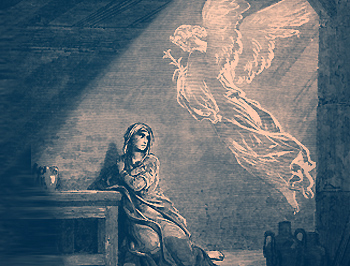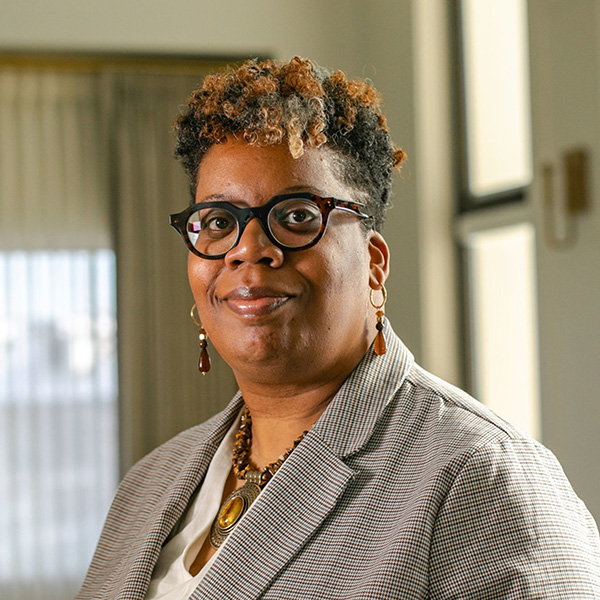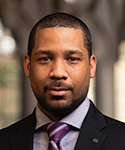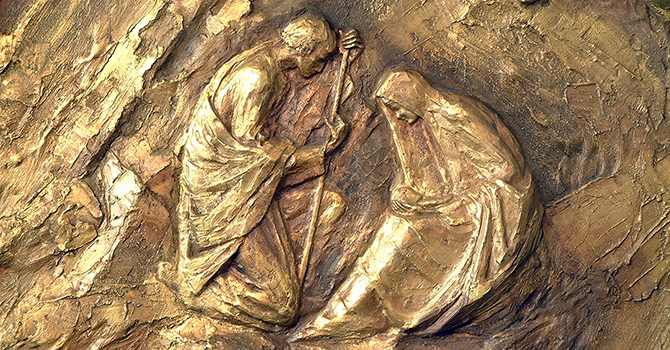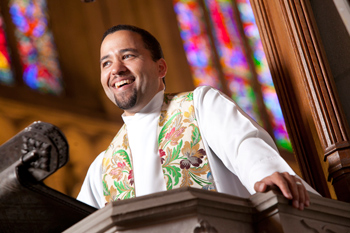Editor’s note: Faith & Leadership offers sermons that shed light on issues of Christian leadership. Michael Pasquarello prepared this sermon for Faith & Leadership for the Fourth Sunday in Advent.
A highly respected pastor, who for many years served a large congregation in New York City, was giving a presentation on preaching. Speaking of the vocation to which he had devoted all of his adult life, he told the audience that while sermons are important, most people who gather to worship do so to pray. I take what this preacher said to mean that many if not most of us who are here this morning have come to be in God’s presence.
I suspect this may sound strange to a lot of pastors and congregations. If there is anything that many churches today would see as getting in the way of their success or effectiveness, it would be gathering for no reason other than to be in God’s presence.
The reason that gathering to pray may sound strange is that when we do so, our attention is turned away from ourselves and toward God. But many pastors and congregations are convinced that their primary mission is to do things for God -- such as marketing the church or changing the world -- so that they have very little time left for sustained attention to God.
Prayer is grounded in the conviction that God speaks as we listen, God gives as we receive, God leads as we follow and God acts as we respond. There is a word we have used in the church to describe this kind of reverent attentiveness to God. It is “humility,” which is not something highly valued in our time, even by the church.
The chapter that opens St. Luke’s Gospel is marked by a deep sense of reverence, attentiveness and receptivity before God. Luke prepares us for the birth of Jesus with a brief description of the humility and devotion displayed by several rather ordinary members of the nation of Israel: Zechariah, Elizabeth and Mary. Zechariah is an old priest, Elizabeth is his childless wife, and Mary is a young, unmarried teenager.
This is the cast that sets the stage for the birth of God’s Son in the world to bring about its salvation. Again, this has got to sound strange to many pastors and congregations. If what we celebrate at Christmas is true -- the birth of Jesus Christ as Israel’s Messiah and Savior of the nations -- this is hardly the kind of supporting cast we would expect to be assembled by God.
We live in a time when interest in religion and spirituality abounds in America. Though older, established denominations continue to experience decline, few First-World countries on the planet have higher levels of church attendance. For this reason, American culture is perceived by other countries as religiously healthy.
In fact, if outsiders pay any attention to the political and cultural discourse in this country, it would be hard for them not to conclude that Americans have a high level of religious enthusiasm and spiritual intensity. Yet such observers may also want to ask how such passion gives form to the shape and pattern of life as a whole, and how the whole of life gives shape to the way we approach the worship of God.
When the church remembers Mary on this Sunday each Advent, the Sunday prior to the celebration of Christ’s nativity, she is remembered for a humility and devotion to God that characterized the whole of her life and was expressive of the whole of Israel’s vocation as God’s covenant people. Yet when her story begins, the first one we hear from is not Mary but Gabriel, a messenger from God who comes to her and announces, “Greetings, favored one! The Lord is with you.”
Mary’s response is one of sheer astonishment; this is not something she is expecting to hear. But what follows is even more astounding:
“You will conceive in your womb and bear a son.”
She then hears more that will evoke her praise for God’s great love:
“The Holy Spirit will come upon you, and the power of the Most High will overshadow you; therefore the child to be born will be holy; he will be called Son of God,” which is followed by this promise: “For nothing will be impossible with God.”
Now Mary finally gets to do something. She gladly receives this life-giving word of good news into herself, becoming pregnant with Jesus -- God’s life becoming flesh in a human life: “Here am I, the servant of the Lord; let it be with me according to your word” (NRSV).
I love what Martin Luther writes about Mary:
When the holy virgin experienced what great things God was working in her despite her insignificance, lowliness, poverty, and inferiority, the Holy Spirit taught her this deep insight and wisdom, that God is the kind of Lord who does nothing but exalt those of low degree and put down the mighty from their thrones, in short, break what is whole and make whole what is broken.
You never know what might happen when we gather to worship and place ourselves in God’s presence, when we join together in common prayer.
There is a well-known congregational (or “common”) prayer from the church’s tradition that is called the Collect for Purity. Listen to what it says; you may recognize it:
Almighty God, to you all hearts are open, all desires known, and from you no secrets are hid: Cleanse the thoughts of our hearts by the inspiration of your Holy Spirit, that we may perfectly love you, and worthily magnify your holy Name; through Christ our Lord. Amen.
I think of this prayer each Advent season, because its words direct our attention to the presence of Christ and the work of the Spirit in a manner that is very much like the devotion of Mary.
According to the blessings spoken by Jesus in the Sermon on the Mount, the pure in heart are those who will see God. In Luke’s first chapter, Zechariah, Elizabeth and Mary are blessed, not because of what they have or what they do, but because of what they hear and see. They are blessed to hear good news of what God is doing in the world, and they are blessed to see what God is bringing about for the life of the world. And what is amazing about all of this is that it takes place among the ordinary people and everyday circumstances of Israel’s worship and life.
There is Elizabeth and there is Mary -- an old, childless woman and a young virgin girl. Both are impossibly pregnant. And what God does with them has strong echoes of the creation story in Genesis: God speaks and the Spirit gives life. Mary’s womb is void until the Spirit of God fills it with the child who is God’s Son. I think this is what Luther meant when he said that God breaks what is whole and makes whole what is broken.
This is what happens when we gather to worship. We place ourselves in God’s presence, hoping to receive God’s self-giving that so moves and empowers us to join Mary in voicing our “yes” to God in the world. And we do this with confidence that our “yes” will be the Spirit’s means of conceiving in us the life of God that was en-fleshed in Jesus and delivered by Mary.
Can you imagine? Can you think of anything that might present more promise or threat of change to the way things are with us and with the world?
I think this is what St. Paul was attempting to put into words as he wrote the Letter to the Romans. The whole creation can be seen as a birth process, a time of pregnant waiting: “We know that the whole creation has been groaning in [travail or] labor pains until now,” and he then immediately adds, “but we ourselves, who have the first fruits of the Spirit, groan inwardly while we wait for adoption, the redemption of our bodies” (NRSV).
Have you ever heard better news? Imagine that when we gather in God’s presence, this sanctuary is a maternity ward, a delivery room, a birthplace for bringing new life into a dying, old world according to the truth of God’s word and by the power of God’s Spirit. Imagine that the pain and travail of life is not a curse but, by the grace of God, the means by which we bring Christ into the world.
Like Mary, we have been called to be fertile, to be a church from which the Spirit brings forth much fruitfulness and life. Like Mary, our vocation is to deliver the Word in the world. And what God desires is our joyful “yes” in response to the word God speaks and our willing receptivity to the life God gives: “Here am I, the servant of the Lord; let it be with me according to your word.”
Mary’s “let it be with me” recalls the “yes” of Jesus in the garden of Gethsemane -- “Nevertheless, not as I will, but as thou wilt” -- as well as the fiat of God at the creation of the world: “And God said, ‘Let there be ...’; ‘let there be ...’”
Mary’s “let it be with me” can be traced all the way back to the Trinity itself.
The “yes” of our obedience to the Word can be both a gift of God and at the same time our action, because it is the expression of holy love. This is the beauty of Mary, who is the first disciple of Jesus and the model of the church. She welcomes the Son of God into the whole of her life, a receptivity to the Word that extends from his birth to his death on a cross.
For this reason, she is “full of grace.” And this is the beauty of our calling as God’s new humanity restored in the image of Christ. Each time we gather, God is pleased to make Jesus present in the world through our prayer and praise, through our preaching of the Word and through our celebration of Holy Communion. We are an impossibly pregnant church; we are a people “full of grace.”
Let it be, Lord, according to your word.
Amen.


